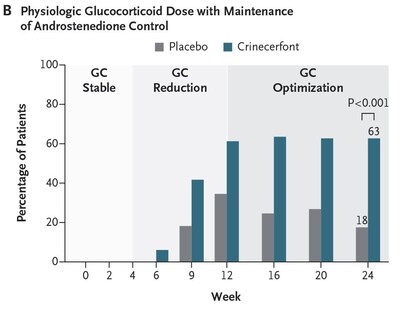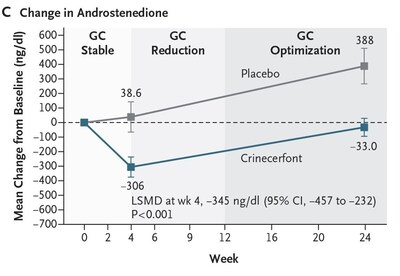- CAHtalyst™ Adult Phase 3 Study Met Primary and Important Key Secondary Endpoints, with Crinecerfont Treatment Decreasing Androstenedione Levels and Enabling Glucocorticoid Dose Reduction While Maintaining Androstenedione Control
- 62.7% of Crinecerfont Participants Achieved a Physiologic Glucocorticoid Dose while Maintaining Androstenedione Control versus 17.5% of Placebo Participants
- Favorable Trends in Endpoints Reflecting Consequences of Supraphysiologic Glucocorticoid Dosing
- Crinecerfont was Generally Well Tolerated
"Since the 1950s, glucocorticoids have been required not only for cortisol replacement, but also to control the excessive amount of adrenal androgens in patients with congenital adrenal hyperplasia. As a result, CAH patients suffer from a higher prevalence of disorders attributable to supraphysiologic GC levels, including osteoporosis, obesity, insulin resistance, diabetes mellitus, hyperlipidemia and hypertension," said Dr.
Crinecerfont is an investigational, oral, selective corticotropin-releasing factor type 1 receptor (CRF1) antagonist being developed to reduce and control excess adrenocorticotropic hormone (ACTH) and adrenal androgens through a GC-independent mechanism for the treatment of CAH.
"The CAHtalyst Adult Phase 3 study demonstrated the ability of crinecerfont to substantially reduce glucocorticoid doses to more physiologic levels while maintaining or improving androgen control," said Eiry W. Roberts, M.D., Chief Medical Officer at
The CAHtalyst Adult Phase 3 global registrational study was conducted in 182 participants and designed to evaluate the safety, efficacy, and tolerability of crinecerfont in adults ages 18 years and older with CAH due to 21-hydroxylase deficiency. Over 95% of participants completed the 24-week double-blind, placebo-controlled treatment period of the study with minimal missing data.
The Phase 3 Adult study met the primary endpoint of percent change from baseline in GC dose (while maintaining androstenedione control) and the key secondary endpoint of achievement of reduction to a physiologic GC dose (while maintaining androstenedione control) at Week 24.
- Crinecerfont treatment led to a significantly greater GC dose reduction at Week 24 while maintaining androstenedione control compared to placebo (least squares mean [LSM] percent change from baseline of -27.3% versus -10.3%, with LS mean difference [LSMD] of -17.0%, P < 0.001). Actual value is P < 0.0001. (Figure A)
- This corresponded to changes of -4.8 and -2.1 mg/m2/day hydrocortisone equivalents for crinecerfont and placebo, respectively
- After the initial 4-week GC stable period, mean percent GC reduction (while androstenedione was controlled) was greater with crinecerfont than placebo at all timepoints, and this effect was maintained from Weeks 12 to 24, while GC levels increased from Weeks 12 to 24 for participants on placebo.
Importantly, a significantly greater proportion of participants treated with crinecerfont achieved reduction to a physiologic GC dose (≤ 11 mg/m2/day) while maintaining androstenedione control compared to placebo (62.7% vs. 17.5%; P < 0.001). Actual value is P < 0.0001. (Figure B)
The Phase 3 Adult study also met the key secondary endpoint of change from baseline in androstenedione (key adrenal androgen) following the initial 4-week GC stable period:
- Crinecerfont treatment led to a significantly greater reduction in androstenedione compared to an increase with placebo at Week 4 (LS mean change from baseline of -299 ng/dL versus +45.5 ng/dL, with LSMD of -345 ng/dL; P < 0.001). Actual value is P < 0.0001.
- The significant reduction in androstenedione levels while GC was stable provides clear evidence of the ability of crinecerfont to reduce elevated adrenal androgen levels through a non-GC mechanism.
At Week 24, mean androstenedione levels remained below baseline with crinecerfont in the context of substantially reduced GC dose. However, androstenedione levels increased to above baseline with placebo, highlighting the inability to maintain androgen control when GC was reduced in the absence of any other intervention. (Figure C)
Despite the short-term duration of this Phase 3 study, favorable trends were observed for endpoints associated with long-term supraphysiologic GC therapy such as body weight, insulin resistance, and glucose tolerance that were encouraging considering the relatively short time frame of reduced GC dose. In addition, bone resorption and formation markers increased more with crinecerfont, reflecting relief from GC-induced suppression of bone turnover.
Crinecerfont was generally well tolerated, with the most common adverse events being fatigue and headache. Few serious adverse events occurred, with none assessed as related to crinecerfont, and there were few discontinuations due to adverse events. There was no safety concern related to adrenal crisis, with few events reported during the double-blind period and similar incidence of adverse events leading to glucocorticoid stress dosing in the crinecerfont and placebo groups.
Note: P-values in the text and figures reflect the Journal's convention of calculating to two significant figures. Actual P-values to three significant figures are also provided. Figures reflect observed means rather than the LSM and LSMD described in the text.
Figures are from
About Congenital Adrenal Hyperplasia
Congenital adrenal hyperplasia (CAH) is a rare genetic condition that results in an enzyme deficiency that alters the production of adrenal hormones which are essential for life. Approximately 95% of CAH cases are caused by a mutation that leads to deficiency of the enzyme 21-hydroxylase (21-OHD). Severe deficiency of this enzyme leads to an inability of the adrenal glands to produce cortisol and, in approximately 75% of cases, aldosterone. If left untreated, CAH can result in salt wasting, dehydration, and even death.
Glucocorticoids (GCs) are currently used not only to correct the endogenous cortisol deficiency, but doses used are higher than cortisol replacement needed (supraphysiologic) to lower the levels of adrenocorticotropic hormone (ACTH) and adrenal androgens. However, glucocorticoid treatment at supraphysiologic doses has been associated with serious and significant complications of steroid excess, including metabolic issues such as weight gain and diabetes, cardiovascular disease, and osteoporosis. Additionally, long-term treatment with supraphysiologic GC doses may have psychological and cognitive impact, such as changes in mood and memory. Adrenal androgen excess has been associated with abnormal bone growth and development in pediatric patients, female health problems such as acne, excess hair growth and menstrual irregularities, testicular rest tumors in males, and fertility issues in both sexes.
To learn more about CAH, click here.
About Crinecerfont and the CAHtalyst™ Studies
Crinecerfont is an investigational, oral, selective corticotropin-releasing factor type 1 receptor (CRF1) antagonist being developed to reduce and control excess adrenocorticotropic hormone (ACTH) and adrenal androgens through a glucocorticoid-independent mechanism for the treatment of congenital adrenal hyperplasia (CAH) due to 21-hydroxylase deficiency. Antagonism of CRF1 receptors in the pituitary has been shown to decrease ACTH levels, which in turn decreases the production of adrenal androgens and potentially the symptoms associated with CAH. Our data demonstrate that lowering adrenal androgen levels enables lower, more physiologic dosing of glucocorticoids and thus could potentially reduce the complications associated with exposure to greater than normal glucocorticoid doses in patients with CAH.
The CAHtalyst™ Pediatric and Adult Phase 3 global registrational studies are designed to evaluate the safety, efficacy, and tolerability of crinecerfont in children and adolescents, and adults respectively, with congenital adrenal hyperplasia due to 21-hydroxylase deficiency. The primary portions of the CAHtalyst Phase 3 studies have completed and enrollment is closed, while the open-label treatment portions of both studies are ongoing. Data from the CAHtalyst Pediatric and CAHtalyst Adult Phase 3 studies supported two New Drug Application submissions to the
To learn more about crinecerfont and the CAHtalyst studies, click here.
About
(*in collaboration with AbbVie)
The NEUROCRINE BIOSCIENCES Logo Lockup and YOU DESERVE BRAVE SCIENCE are registered trademarks of
Forward-Looking Statements
In addition to historical facts, this press release contains forward-looking statements that involve a number of risks and uncertainties. These statements include, but are not limited to, statements regarding the potential benefits to be derived from crinecerfont. Among the factors that could cause actual results to differ materially from those indicated in the forward-looking statements include: the crinecerfont NDAs may not be accepted for filing by the FDA or may not obtain regulatory approval or such approval may be delayed; additional regulatory submissions may not occur or be submitted in a timely manner; the FDA may make adverse decisions regarding crinecerfont; crinecerfont may not be found to be safe and/or effective or may not prove to be beneficial to patients; development activities for crinecerfont may not be completed on time or at all; clinical development activities may be delayed for regulatory or other reasons, may not be successful or replicate previous and/or interim clinical trial results, or may not be predictive of real-world results or of results in subsequent clinical trials; competitive products and technological changes that may limit demand for our products; uncertainties relating to patent protection and intellectual property rights of third parties; our dependence on third parties for development and manufacturing activities related to crinecerfont, and our ability to manage these third parties; our future financial and operating performance; risks and uncertainties associated with the commercialization of our products; and other risks described in the Company's periodic reports filed with the
![]() View original content to download multimedia:https://www.prnewswire.com/news-releases/neurocrine-biosciences-announces-publication-of-primary-cahtalyst-adult-phase-3-study-results-of-crinecerfont-for-the-treatment-of-cah-in-the-new-england-journal-of-medicine-302161424.html
View original content to download multimedia:https://www.prnewswire.com/news-releases/neurocrine-biosciences-announces-publication-of-primary-cahtalyst-adult-phase-3-study-results-of-crinecerfont-for-the-treatment-of-cah-in-the-new-england-journal-of-medicine-302161424.html
SOURCE
CONTACTS: Media: Linda Seaton, 1-858-617-7292, media@neurocrine.com; Investors: Todd Tushla, 1-858-617-7143, ir@neurocrine.com




